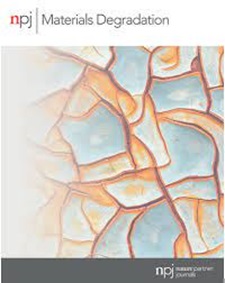高温时效贫双相不锈钢2404的晶间腐蚀与自愈机制
IF 7.6
2区 材料科学
Q1 MATERIALS SCIENCE, MULTIDISCIPLINARY
引用次数: 0
摘要
采用电化学方法、热力学计算和动力学模型研究了贫双相不锈钢2404在700和800℃长期时效后的晶间腐蚀机理。在700℃时,σ相生长显著提高了敏化度(DOS),降低了击穿电位(Eb)。在800℃时,铁素体/σ界面处的自愈过程有助于恢复Cr和Mo贫化区域,在时效72 h后降低DOS,在高电极电位下24 h后稳定Eb。然而,腐蚀过程在σ/奥氏体界面处加剧,随着时效时间的延长,其抗晶间腐蚀性能下降。结果表明,当形成大量σ相时,合金的耐蚀性不能通过自愈完全恢复。此外,DICTRA计算有效地评估了σ相增长导致的耐蚀性退化,从而对晶间腐蚀机制有了更深入的了解。本文章由计算机程序翻译,如有差异,请以英文原文为准。

Mechanisms of intergranular corrosion and self-healing in high temperature aged lean duplex stainless steel 2404
This study investigated the intergranular corrosion mechanism of lean duplex stainless steel 2404 after long-term aging at 700 and 800 °C using electrochemical methods, thermodynamic calculations, and kinetic models. At 700 °C, σ phase growth significantly increases the degree of sensitization (DOS) and decreases the breakdown potential (Eb). At 800 °C, a self-healing process at the ferrite/σ interface helps recover Cr and Mo depleted regions, reducing DOS after 72 h of aging and stabilizing Eb after 24 h at higher electrode potentials. However, the corrosion process is intensified at the σ/austenite interface, compromising intergranular corrosion resistance during prolonged aging. The findings show that complete recovery of corrosion resistance via self-healing is not achieved when high fractions of σ phase are formed. In addition, DICTRA calculations effectively evaluate corrosion resistance degradation from σ phase growth, providing deeper insights into the intergranular corrosion mechanism.
求助全文
通过发布文献求助,成功后即可免费获取论文全文。
去求助
来源期刊

npj Materials Degradation
MATERIALS SCIENCE, MULTIDISCIPLINARY-
CiteScore
7.80
自引率
7.80%
发文量
86
审稿时长
6 weeks
期刊介绍:
npj Materials Degradation considers basic and applied research that explores all aspects of the degradation of metallic and non-metallic materials. The journal broadly defines ‘materials degradation’ as a reduction in the ability of a material to perform its task in-service as a result of environmental exposure.
The journal covers a broad range of topics including but not limited to:
-Degradation of metals, glasses, minerals, polymers, ceramics, cements and composites in natural and engineered environments, as a result of various stimuli
-Computational and experimental studies of degradation mechanisms and kinetics
-Characterization of degradation by traditional and emerging techniques
-New approaches and technologies for enhancing resistance to degradation
-Inspection and monitoring techniques for materials in-service, such as sensing technologies
 求助内容:
求助内容: 应助结果提醒方式:
应助结果提醒方式:


